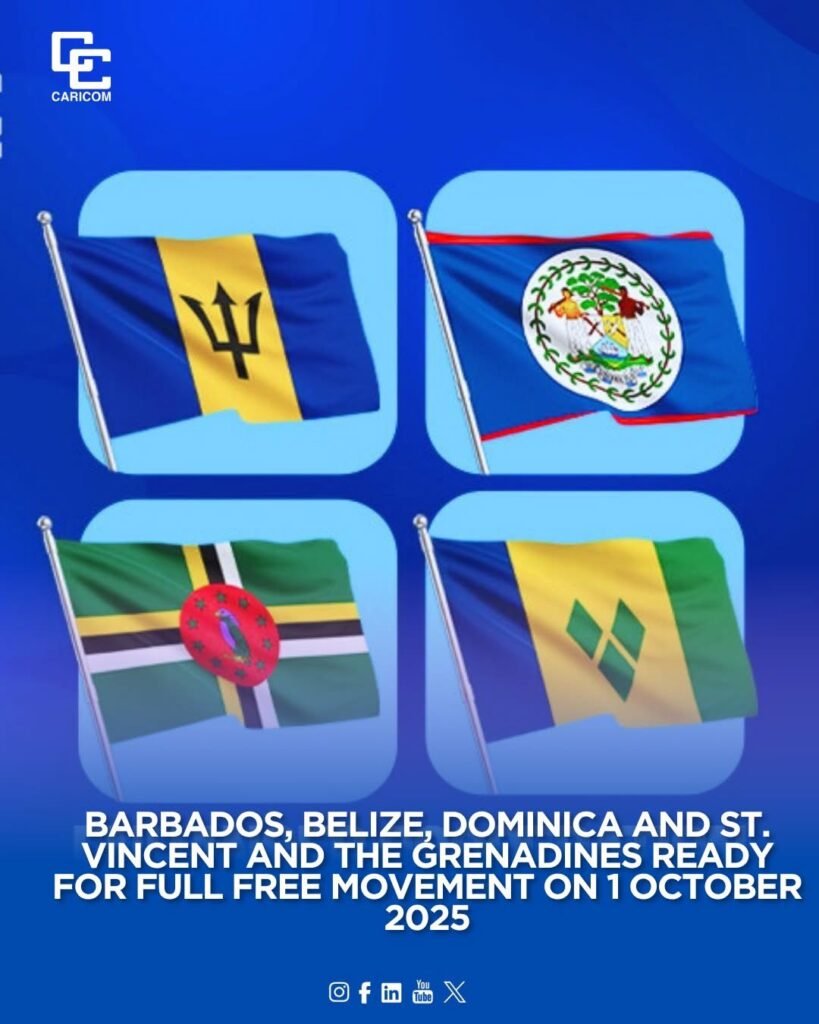October 1, 2025 – When four CARICOM countries- Barbados, Belize, Dominica, and St. Vincent and the Grenadines- implement full free movement of their nationals today October 1, 2025, it will mark a significant shift in the trajectory of regional integration. For the first time, a subset of CARICOM Member States will move beyond temporary stays and the skills regime, allowing their nationals to live, work, and remain indefinitely across borders, with access to healthcare and education.
This development is rightly being celebrated as a breakthrough, but it also invites reflection: hasn’t the OECS already been here for over a decade?
The OECS Model: Ahead of the Curve

Through the Revised Treaty of Basseterre (2011), the OECS created its Economic Union, a bold arrangement that grants citizens of its Member States the right to:
- enter and reside indefinitely in any other OECS state,
- work freely without permits,
- establish businesses, and
- access public health care and education for their children.
For Antiguans and Barbudans, this freedom of movement within the OECS has been part of daily life since 2011–2012. Migrating to St. Kitts & Nevis for employment, moving to Dominica for family reasons, or starting a business in Grenada has required no skills certificate, no work permit, and no complex bureaucracy.
In short, the OECS has long demonstrated that small states can achieve deep integration when political will aligns with economic necessity.
CARICOM’s Uneven Path
By contrast, CARICOM’s free movement has been limited. The CSME Skills Regime only applies to approved categories: graduates, nurses, artisans, media workers, and others who qualify with a Skills Certificate. For everyone else, the standard six-month stay applies.
This has left CARICOM’s integration project uneven and sometimes frustrating. Citizens from larger countries such as Jamaica and Trinidad & Tobago, when moving through OECS states, sometimes observe the privileges OECS nationals enjoy but remain excluded from them. Smaller states, meanwhile, balance opportunities with concerns about labour absorption and service delivery.
Enhanced Cooperation: A Bridge Between Two Worlds
The decision by Barbados, Belize, Dominica, and St. Vincent to go further under the Enhanced Cooperation Protocol of the Revised Treaty of Chaguaramas signals that CARICOM is willing to experiment.

For Dominica and St. Vincent, both OECS members, the move is not new. However, by aligning with Barbados and Belize, they become bridges between the OECS and the wider CARICOM. This creates a nucleus of countries pushing forward with more unrestricted movement, while others observe and decide whether to join later.
The practical steps being rolled out are noteworthy:
- Indefinite stay stamps/digital records on arrival,
- Registration systems for access to services,
- Security and health safeguards through CARICOM IMPACS,
- and a complaints mechanism under the CSME.
These are precisely the mechanisms needed to make free movement functional and sustainable.
What It Means for Antigua and Barbuda
For Antiguans and Barbudans, the OECS freedoms already exist. But this new CARICOM bloc signals that CARICOM is finally edging closer to the OECS model of integration.
Despite not having “free movement” in the strict CARICOM sense, Antigua and Barbuda has long been facilitating the movement of labour and capital from across the region. Our twin-island state is arguably the CARICOM nation where the populations of other Member States are most visible, integrated, and significant.
This openness has enriched our society and economy, but it also presents risks in the new landscape. Naturally, free movement arrangements reduce costs and related barriers, widening access to labour pools across multiple sectors. Yet, there could be adverse consequences if two of Antigua and Barbuda’s traditional labour source markets, Dominica and St. Vincent, begin to see their nationals drawn instead to new opportunities in Barbados and Belize under Enhanced Cooperation.
For businesses, policymakers, and workers here at home, this underscores the need to stay competitive, ensuring that Antigua and Barbuda remains an attractive destination for regional talent even as integration deepens elsewhere.
The Road Ahead
Both the OECS and CARICOM experiments underline a simple truth: integration is not just about treaties, it’s about people.
The OECS has demonstrated that deep integration can be effective when governments and citizens are committed. Now, CARICOM, through this pilot arrangement, can present the same. For Antigua and Barbuda, the challenge is to remain at the forefront, defending the freedoms we already enjoy under the OECS, while pressing for the day when all CARICOM nationals can move as freely as we do within the OECS family.
Eye on the Economy explores issues that shape Antigua and Barbuda’s economic development and its place in the wider Caribbean. This is the latest series by Petra Williams on petrathespectator.com. Please feel free to share your comments in the section below or email them directly to peachpw@gmail.com

